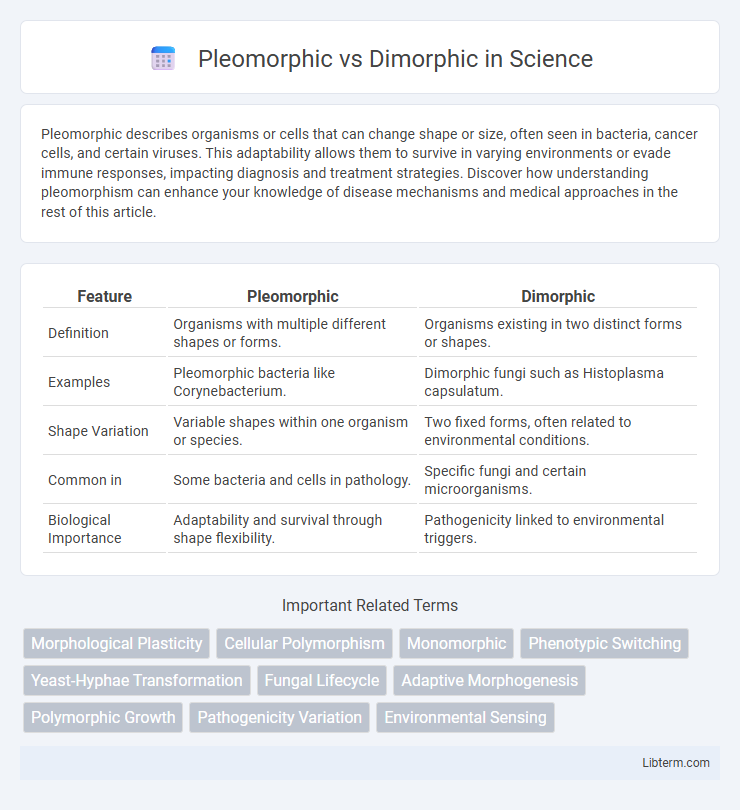Pleomorphic describes organisms or cells that can change shape or size, often seen in bacteria, cancer cells, and certain viruses. This adaptability allows them to survive in varying environments or evade immune responses, impacting diagnosis and treatment strategies. Discover how understanding pleomorphism can enhance your knowledge of disease mechanisms and medical approaches in the rest of this article.
Table of Comparison
| Feature | Pleomorphic | Dimorphic |
|---|---|---|
| Definition | Organisms with multiple different shapes or forms. | Organisms existing in two distinct forms or shapes. |
| Examples | Pleomorphic bacteria like Corynebacterium. | Dimorphic fungi such as Histoplasma capsulatum. |
| Shape Variation | Variable shapes within one organism or species. | Two fixed forms, often related to environmental conditions. |
| Common in | Some bacteria and cells in pathology. | Specific fungi and certain microorganisms. |
| Biological Importance | Adaptability and survival through shape flexibility. | Pathogenicity linked to environmental triggers. |
Understanding Pleomorphism and Dimorphism
Pleomorphism refers to the ability of certain microorganisms, such as bacteria or fungi, to exhibit multiple distinct shapes or forms during their life cycle or in response to environmental changes. Dimorphism specifically describes organisms that alternate between two distinct morphological forms, often linked to their pathogenicity, such as the yeast-to-mold transition in fungi like Histoplasma capsulatum. Understanding pleomorphism and dimorphism is crucial for diagnosing infections, as these shape-shifting properties influence microbial identification, adaptability, and virulence.
Key Differences Between Pleomorphic and Dimorphic Organisms
Pleomorphic organisms exhibit multiple distinct morphological forms within a single species, often adapting their shape or size in response to environmental conditions. Dimorphic organisms specifically have two distinct forms or stages, typically alternating between yeast and mold phases in fungi or male and female forms in animals. The key difference lies in pleomorphism's capacity for varied shapes beyond just two, whereas dimorphism consistently involves exactly two distinct morphological types.
Examples of Pleomorphic Microorganisms
Pleomorphic microorganisms, such as *Mycoplasma* species and *Corynebacterium* diphtheriae, exhibit variability in shape and size depending on environmental conditions. Unlike dimorphic fungi like *Histoplasma capsulatum*, which switch between yeast and mold forms, pleomorphic bacteria lack a consistent morphology, complicating identification and treatment. This morphological flexibility allows pleomorphic organisms to adapt to diverse habitats and evade host immune responses.
Examples of Dimorphic Microorganisms
Dimorphic microorganisms exhibit two distinct morphological forms, typically switching between yeast and mold depending on environmental conditions. Examples of dimorphic fungi include Histoplasma capsulatum, responsible for histoplasmosis, which grows as a mold in soil but transforms into yeast within human hosts. Another example is Blastomyces dermatitidis, the causative agent of blastomycosis, demonstrating similar dimorphic behavior essential for pathogenicity and diagnosis.
Morphological Adaptations and Survival
Pleomorphic organisms exhibit multiple distinct morphological forms, enabling dynamic adaptation to varying environmental conditions, which enhances their survival by increasing phenotypic plasticity. Dimorphic species display two stable morphological forms, often linked to reproductive or environmental roles, allowing specialization that optimizes their fitness in fluctuating habitats. Morphological adaptations in both pleomorphic and dimorphic organisms confer critical advantages for resource utilization, predator avoidance, and resilience under stress, driving evolutionary success.
Clinical Significance of Pleomorphism
Pleomorphism in clinical pathology indicates variability in the size, shape, and appearance of cells or nuclei, often signaling malignancy or aggressive tumor behavior. Dimorphism refers to the presence of two distinct morphological forms, commonly seen in certain fungal infections but less associated with cancer prognosis. The detection of pleomorphic cells in biopsies aids in diagnosing high-grade tumors, guiding treatment decisions and predicting patient outcomes.
Clinical Implications of Dimorphism
Dimorphic fungi exhibit two distinct morphological forms--yeast and mold--that significantly impact clinical diagnosis and treatment strategies. The ability of dimorphic fungi such as Histoplasma capsulatum and Blastomyces dermatitidis to switch forms in response to host temperature complicates identification and requires antifungal therapies tailored to the specific phase of infection. Understanding dimorphism is crucial for accurate clinical management, as misidentification may lead to ineffective treatments and increased morbidity in systemic mycoses.
Diagnostic Challenges: Pleomorphic vs Dimorphic
Pleomorphic and dimorphic fungi present distinct diagnostic challenges due to their variable morphologies; pleomorphic fungi exhibit multiple forms depending on environmental conditions, complicating microscopic identification. Dimorphic fungi switch between yeast and mold forms based on temperature, requiring precise culture techniques and molecular assays for accurate detection. Misidentification can delay effective treatment and impact clinical outcomes, emphasizing the need for advanced diagnostic protocols in medical mycology.
Treatment Approaches for Pleomorphic and Dimorphic Infections
Treatment approaches for pleomorphic infections often require broad-spectrum antibiotics or antiviral agents due to the organism's variable morphology and adaptive resistance mechanisms. Dimorphic infections, typically caused by fungi that switch between mold and yeast forms, demand antifungal medications tailored to the infection stage, such as amphotericin B for systemic cases and itraconazole for milder or localized infections. Accurate diagnosis of the morphological state is crucial in guiding effective therapy to ensure optimal patient outcomes and prevent resistance development.
Pleomorphism and Dimorphism: Impact on Public Health
Pleomorphism refers to the ability of certain microorganisms, such as some bacteria and fungi, to alter their shape or size in response to environmental conditions, complicating diagnosis and treatment strategies. Dimorphism specifically describes organisms, like certain pathogenic fungi, that exist in two distinct morphological forms--usually a yeast form and a mold form--enabling adaptation to different host environments and enhancing virulence. Understanding pleomorphism and dimorphism is critical for public health because these characteristics influence the infectious potential, resistance to therapeutic interventions, and epidemiological patterns of microbial diseases.
Pleomorphic Infographic

 libterm.com
libterm.com